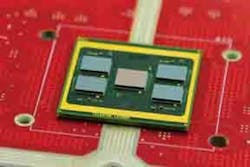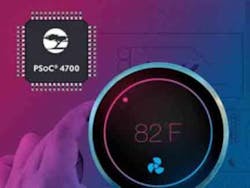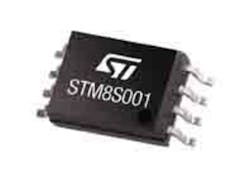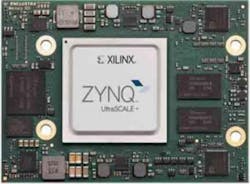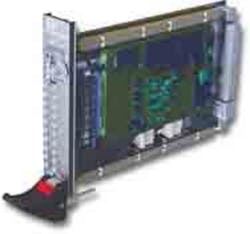Data-conversion options span monolithic ICs to modules and boards
Data converters are at the heart of many products in an increasingly digitalized world—test instruments as an example. Teledyne LeCroy’s new WavePro HD high-definition oscilloscopes, for instance, are built around a new chipset shown in the nearby figure incorporating 12-bit, 20-GS/s ADCs, plus high-SNR 8-GHz front-end amplifiers, according to Patrick Connally, technical marketing engineer. This chipset is custom—to take advantage of it, you’ll need to purchase one of the new 8-GHz, 12-bit scopes.
Beyond custom data converters built into an end product, you have many data-conversion options to choose from, including monolithic data converters, microcontrollers or SoCs with built-in data converters, and modules and boards with data-conversion functions. Taking the board and module approach is Pentek Inc. with its recently introduced Model 5950, an 8-channel A/D and D/A converter based on the Xilinx Zynq UltraScale+ RFSoC. It’s available as a 3U OpenVPX board or, explained vice president Rodger Hosking, customers can purchase the QuartzXM eXpress module for applications with severe space limitations. It includes the RFSoC and handles functions like power management, providing the multiple supply levels the RFSoC requires from a single 12-V input.
The highlights below indicate some specific options available.
Touch-input microcontrollers
The PSoC 4700S Series microcontrollers (MCUs) use inductive sensing to detect touch inputs for products using metal surfaces, enabling reliable and waterproof human-machine interfaces. PSoC 4700S features include a 32-bit MCU subsystem, 48-MHz Arm Cortex-M0+Low-power DAC
The AD5758 digital-to-analog converter incorporates the company’s second-generation Dynamic Power Control (DPC) to enable high-density analog-output modules without requiring derating—the need to turn off channels due to thermal build up—resulting in lower cost, more compact designs. This single-channel current/voltage DAC with DPC is designed for channel-to-channel isolated industrial applications in factory automation and motor control. The AD5758 is the vendor’s lowest-power industrial DAC.
The AD5758 features a 5-mm x 5-mm footprint as well as robust construction that requires fewer external protection components, supporting smaller, lower-cost designs. It is engineered with advanced diagnostics that provide visibility into system performance for higher reliability and planned maintenance schedules. The AD5758 also includes output fault-protection circuits to safeguard the DAC in the event of a miswire incident.
The AD5758 includes integrated diagnostics for high system reliability. The device’s 0.05% total unadjusted error (TUE) is two times better than the industry standard, the company reports. Analog Devices Inc.
MCU with 3-channel 10-bit ADC
The 8-bit STM8S001 microcontroller (MCU) comes in an SO-8 package and features I2C, UART, and SPI interfaces. With 8-kB flash memory, 1-kB RAM, 128-byte EEPROM, and 3-channel 10-bit ADC also on-chip, it delivers key features of the vendor’s STM8S003 MCUNFC smart-sensor IC
The AS39513 can be integrated into smart labels to enable efficient and accurate monitoring of the condition of assets such as food, pharmaceuticals, and healthcare products in storage and in transit. It includes an NFC front end, a temperature sensor, and an analog interface to an external sensor. Other functions integrated in the IC are a real-time clock, a 10-bit ADC, a configurable data-logging engine, a 9-kb password-protected EEPROM, and a serial peripheral interface (SPI) to connect to an external microcontroller. The AS39513 is available as a bumped die or in a chipscale package that is 0.3 mm high.
Powered by a single-cell or dual-cell battery, the AS39513 can store up to 1,020 time-stamped sensor measurements. Fully compliant with ISO15693 and NFC-V (T5T) standards, it can be read over a range of a few centimeters with an NFC mobile phone. An extended read range of 1 to 2 m can be achieved when using dedicated ISO15693 readers, offering the ability to read multiple AS39513 tags simultaneously in cabinets or refrigerators. ams
MCU with 16-bit SAR ADC
To meet growing connectivity needs for buildings, factories, and the grid, the vendor’s newest SimpleLink wireless and wired microcontrollers (MCUs) offer low power consumption and concurrent multistandard and multiband connectivity for Thread, Zigbee, and Bluetooth 5 as well as sub-1 GHz communications interfaces. The expanded SimpleLink MCU platform offers designers 100% code reuse across the vendor’s Arm Cortex-M4-based MCUs.
The device’s 2 MB of flash memory and an integrated 16-bit SAR precision ADC give developers eight times more code space and the ability to host multiple wireless connectivity stacks and a 320-segment LCD with extended temperature range for industrial applications. The vendor says the precision ADC offers the highest effective number of bits (ENOB) of any integrated ADC, boasting 13.2 ENOB at 1 MS/s and up to 16 ENOB with software oversampling. The combination of 16-bit precision, ultralow sampling current, and integrated 8-channel DMA makes the MSP432P4 suitable for both high-performance and low-power applications.
The module supports differential and single-ended inputs, and direct data transfer using DMA. Texas Instruments
Battery monitor with SAR ADC
The MAX17843 programmable, high-voltage, 12-channel battery-monitoring smart data-acquisition interface is optimized for batteries used in automotive systems, hybrid electric battery packs, electric cars, and any system that stacks long series strings of secondary metal batteries. This highly integrated battery sensor incorporates a high-speed differential UART bus for robust daisy-chained serial communication.
The analog front-end combines a 12-channel voltage-measurement data-acquisition system with a high-voltage switch-bank input. All measurements are done differentially across each cell. The full-scale measurement range is from 0 to 5.0 V with a usable range of 0.2 V to 4.8 V. A high-speed successive approximation (SAR) A/D converter digitizes cell voltages at 14-bit resolution with oversampling. All 12 cells can be measured in less than 142 µs. The MAX17843 uses a 2-scan approach for collecting cell measurements and correcting them for errors. This 2-phase approach optimizes accuracy over temperature and in the face of extreme noise in the system.
Two auxiliary analog inputs can measure external thermistor components. A negative temperature coefficient (NTC) thermistor can be configured with the AUXIN analog inputs to accurately monitor module or battery-cell temperature. A thermal-overload detector disables the MAX17843’s linear regulator to protect the IC, and a die-temperature measurement is also available. Maxim Integrated
